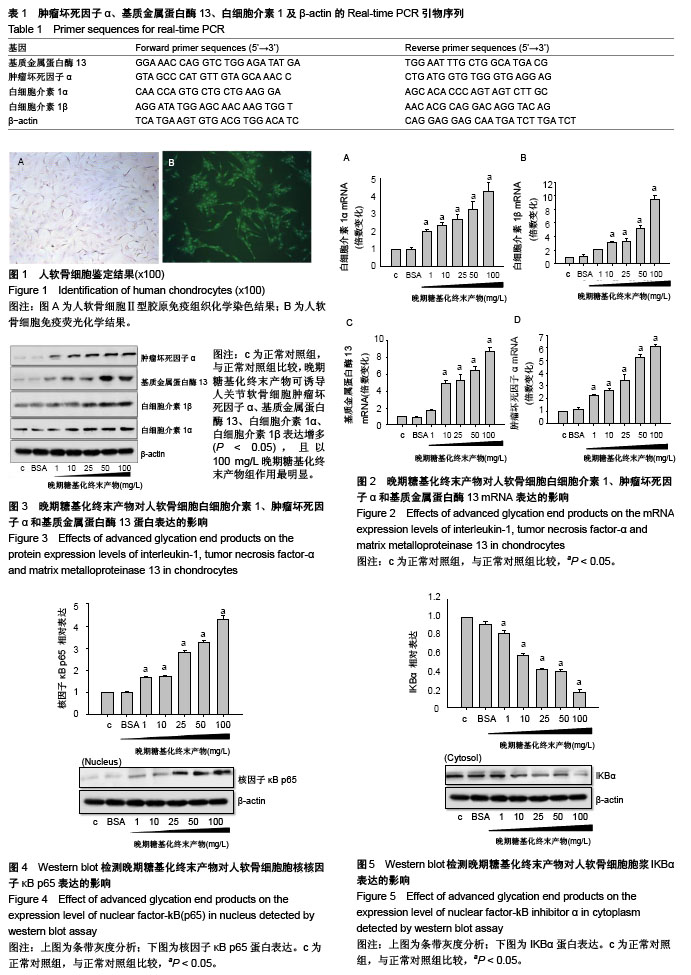中国组织工程研究 ›› 2018, Vol. 22 ›› Issue (24): 3786-3791.doi: 10.3969/j.issn.2095-4344.0826
• 软骨组织构建 cartilage tissue construction • 上一篇 下一篇
晚期糖基化终末产物致软骨细胞炎性反应的潜在机制
赵 峻1,马 翅1,杨娜娜2,唐 欣1,刘唐浩1,谭扬帆1,彭秀娟1,陈 铖3
- 1湘西自治州人民医院/吉首大学第一附属医院,湖南省吉首市 416000;2湖南师范大学医学院,湖南省长沙市 410006;3湖南师范大学第二附属医院/解放军一六三医院,湖南省长沙市 410003
Potential mechanism of advanced glycation end products inducing inflammatory reactions in chondrocytes
Zhao Jun1, Ma Chi1, Yang Na-na2, Tang Xin1, Liu Tang-hao1, Tan Yang-fan1, Peng Xiu-juan1, Chen Cheng3
- 1People’s Hospital of Xiangxi Autonomous Prefecture & the First Affiliated Hospital of Jishou University, Jishou 416000, Hunan Province, China; 2School of Medicine, Hunan Normal University, Changsha 410006, Hunan Province, China; 3the Second Affiliated Hospital of Hunan Normal University & No. 163 Hospital of Chinese PLA, Changsha 410003, Hunan Province, China
摘要:
文章快速阅读:
.jpg) 文题释义:
晚期糖基化终末产物:是过量的糖和蛋白质结合的产物,在体内有两个来源,一是过量的糖和蛋白质在体内合成晚期糖基化终末产物,二是通过进食将食物中存在的晚期糖基化终末产物摄入体内。晚期糖基化终末产物能够和身体的组织细胞相组合并破坏它们。目前的研究证明,晚期糖基化终末产物会加速人体的衰老和导致很多慢性退化型疾病的发生。
核因子κB:核因子κB体系主要涉及机体防御反应、组织损伤和应激、细胞分化和凋亡以及肿瘤生长抑制过程的信息传递。在多数细胞浆内核因子κB与抑制蛋白结合形成无活性复合物,当信息物质作用于相应受体后,磷酸化抑制蛋白使核因子κB脱落而活化,核因子κB进入胞核影响基因转录。
文题释义:
晚期糖基化终末产物:是过量的糖和蛋白质结合的产物,在体内有两个来源,一是过量的糖和蛋白质在体内合成晚期糖基化终末产物,二是通过进食将食物中存在的晚期糖基化终末产物摄入体内。晚期糖基化终末产物能够和身体的组织细胞相组合并破坏它们。目前的研究证明,晚期糖基化终末产物会加速人体的衰老和导致很多慢性退化型疾病的发生。
核因子κB:核因子κB体系主要涉及机体防御反应、组织损伤和应激、细胞分化和凋亡以及肿瘤生长抑制过程的信息传递。在多数细胞浆内核因子κB与抑制蛋白结合形成无活性复合物,当信息物质作用于相应受体后,磷酸化抑制蛋白使核因子κB脱落而活化,核因子κB进入胞核影响基因转录。
.jpg) 文题释义:
晚期糖基化终末产物:是过量的糖和蛋白质结合的产物,在体内有两个来源,一是过量的糖和蛋白质在体内合成晚期糖基化终末产物,二是通过进食将食物中存在的晚期糖基化终末产物摄入体内。晚期糖基化终末产物能够和身体的组织细胞相组合并破坏它们。目前的研究证明,晚期糖基化终末产物会加速人体的衰老和导致很多慢性退化型疾病的发生。
核因子κB:核因子κB体系主要涉及机体防御反应、组织损伤和应激、细胞分化和凋亡以及肿瘤生长抑制过程的信息传递。在多数细胞浆内核因子κB与抑制蛋白结合形成无活性复合物,当信息物质作用于相应受体后,磷酸化抑制蛋白使核因子κB脱落而活化,核因子κB进入胞核影响基因转录。
文题释义:
晚期糖基化终末产物:是过量的糖和蛋白质结合的产物,在体内有两个来源,一是过量的糖和蛋白质在体内合成晚期糖基化终末产物,二是通过进食将食物中存在的晚期糖基化终末产物摄入体内。晚期糖基化终末产物能够和身体的组织细胞相组合并破坏它们。目前的研究证明,晚期糖基化终末产物会加速人体的衰老和导致很多慢性退化型疾病的发生。
核因子κB:核因子κB体系主要涉及机体防御反应、组织损伤和应激、细胞分化和凋亡以及肿瘤生长抑制过程的信息传递。在多数细胞浆内核因子κB与抑制蛋白结合形成无活性复合物,当信息物质作用于相应受体后,磷酸化抑制蛋白使核因子κB脱落而活化,核因子κB进入胞核影响基因转录。摘要
背景:前期研究表明,晚期糖基化终末产物与兔软骨细胞共同孵育后,肿瘤坏死因子α和基质金属蛋白酶13等炎性因子与基质降解因子表达明显增多。然而,晚期糖基化终末产物致软骨细胞损伤的机制远未阐明。
目的:观察晚期糖基化终末产物对人关节软骨细胞炎性因子与基质降解因子表达及核因子KB活化水平的影响,初步探讨晚期糖基化终末产物诱软骨细胞损伤的潜在机制。
方法:运用机械分离与两步酶顺序消化法分离培养人软骨细胞,并用Ⅱ型胶原免疫组织化学染色以及细胞免疫荧光对人软骨细胞进行鉴定。采用不同质量浓度晚期糖基化终末产物(1,10,25,50,100 mg/L)干预人软骨细胞;并以正常人软骨细胞及BSA干预为对照,24 h后采用Real-time PCR及Western blot检测肿瘤坏死因子α、基质金属蛋白酶13、白细胞介素1三者的mRNA及蛋白表达水平,采用Western blot检测人软骨细胞胞浆中IKBα及胞核中核因子κB p65的含量。
结果与结论:①与对照组比较,晚期糖基化终末产物可浓度依赖性地诱导人关节软骨细胞肿瘤坏死因子α、基质金属蛋白酶13、白细胞介素1α、白细胞介素1β表达增多,且以100 mg/L组作用最明显;②晚期糖基化终末产物处理组中软骨细胞胞浆中IKBα含量明显减少、而胞核中核因子κB p65的含量明显增多;③结果说明,晚期糖基化终末产物诱导白细胞介素1、基质金属蛋白酶13和肿瘤坏死因子α表达增多,其机制可能与核因子KB信号通路有关。
中国组织工程研究杂志出版内容重点:组织构建;骨细胞;软骨细胞;细胞培养;成纤维细胞;血管内皮细胞;骨质疏松;组织工程
ORCID: 0000-0003-3421-750X(赵峻)
中图分类号:

.jpg) 文题释义:
晚期糖基化终末产物:是过量的糖和蛋白质结合的产物,在体内有两个来源,一是过量的糖和蛋白质在体内合成晚期糖基化终末产物,二是通过进食将食物中存在的晚期糖基化终末产物摄入体内。晚期糖基化终末产物能够和身体的组织细胞相组合并破坏它们。目前的研究证明,晚期糖基化终末产物会加速人体的衰老和导致很多慢性退化型疾病的发生。
核因子κB:核因子κB体系主要涉及机体防御反应、组织损伤和应激、细胞分化和凋亡以及肿瘤生长抑制过程的信息传递。在多数细胞浆内核因子κB与抑制蛋白结合形成无活性复合物,当信息物质作用于相应受体后,磷酸化抑制蛋白使核因子κB脱落而活化,核因子κB进入胞核影响基因转录。
文题释义:
晚期糖基化终末产物:是过量的糖和蛋白质结合的产物,在体内有两个来源,一是过量的糖和蛋白质在体内合成晚期糖基化终末产物,二是通过进食将食物中存在的晚期糖基化终末产物摄入体内。晚期糖基化终末产物能够和身体的组织细胞相组合并破坏它们。目前的研究证明,晚期糖基化终末产物会加速人体的衰老和导致很多慢性退化型疾病的发生。
核因子κB:核因子κB体系主要涉及机体防御反应、组织损伤和应激、细胞分化和凋亡以及肿瘤生长抑制过程的信息传递。在多数细胞浆内核因子κB与抑制蛋白结合形成无活性复合物,当信息物质作用于相应受体后,磷酸化抑制蛋白使核因子κB脱落而活化,核因子κB进入胞核影响基因转录。